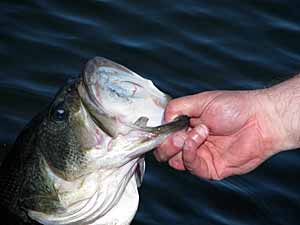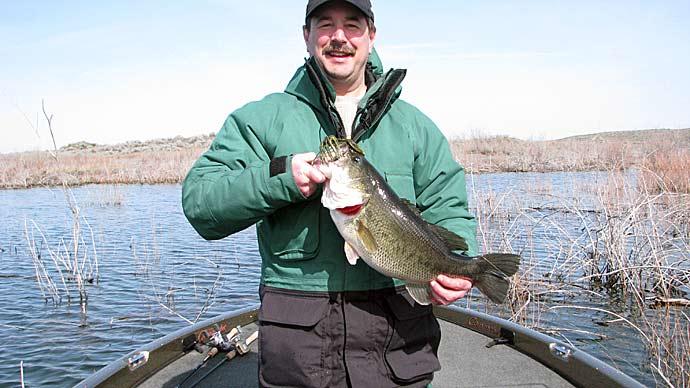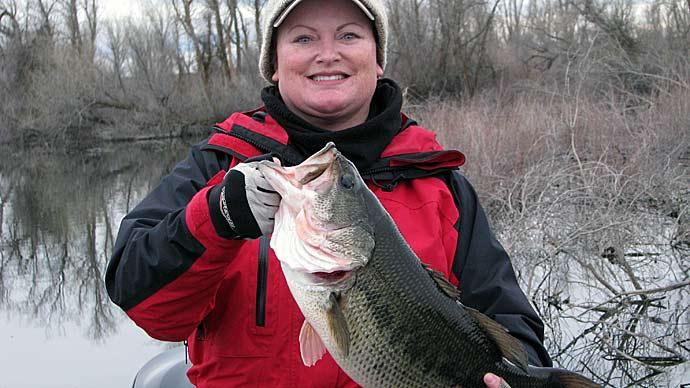
So you think you want to grow trophy bass? If so, get ready to feed them, feed them well - and this may be more of a challenge than you realize.
Recent research suggests that largemouth bass, under optimal conditions, are capable of consuming as much as 5 percent of their body weight daily. That means a 5-pound bass, feeding at maximum efficiency, will consume a quarter pound per day ... nearly 2 pounds per week... over 50 pounds during a normal growing season (March-October).
That's 10 times its body weight, just during the growing season!
Let's assume that the typical pond has roughly 125 pounds per acre of largemouth bass, ranging in size from juveniles to mature adults. Given this model, these individuals would consume as much as six-plus pounds of forage per day... over 40 pounds in a week ... and more than 1,300 pounds in a growing season.
This is for one acre.
In a 10-acre lake, multiply that number by 10! It is true, these numbers represent "ideal" conditions; in nature, these seldom exist and rarely for long without an interruption. Nevertheless, by considering the amazing feeding ability of the largemouth bass we quickly understand why these classic top-end predators are often referred to as the saber-tooth tiger of the 21st century.
Opportunistic to the core, these feeding machines will feed early and often, any hour of the day or night and under a wide range of environmental conditions.
Despite all of this, largemouth bass are cold-blooded, their body temperature strictly dictated by their surroundings. Herein lies the rub.
While a largemouth, in the presence of ample forage, will feed aggressively and frequently, the nature of a cold-blooded creature is to "shut down" when food is scarce. Rather than expending energy "on the prowl" and actively looking for food, largemouth - especially in conditions where forage is limited - rely primarily on ambush tactics, lying in wait for some unsuspecting critter to wander too close.
I have personally witnessed fish populations where food is so limited that the average largemouth bass, 4, 5, or 6 years of age, weighs less than a pound. In fact, these or similar conditions are not all too uncommon in private ponds where nearly non-existent bass harvest has resulted in severe crowding and over-population.
In most cases, the consistent and ample harvest of largemouth is an absolute requisite to producing "quality" and "trophy" size individuals in ponds. In the absence of adequate harvest, these remarkably efficient predators will literally eat themselves out of house and home.
The critical need for harvest aside, let's focus on the other side of the bass growing equation - growing food to feed your bass.
The idea of adding forage to a lake or pond, in an effort to increase foraging opportunities and enhance feeding efficiency, is not a new one. What is somewhat fresh, is the amazing diversity of species which are presently utilized for this purpose. So novel are many of these techniques, that contemporary fisheries science has yet to rule on which ones work best, or work at all.
What's more, given the drastic reductions in budgets and the overall lack of funding for this type of research at the university level, far too few of these revolutionary approaches may ever see the kind of intensive research enjoyed by the majority of the pond management tenets of today. Subjects such as initial stocking ratios, fertilization techniques and liming techniques are all commonly accepted cornerstones of proper pond management, the result of exhaustive research at colleges and universities across the country.
Without new research, the determination of what works best may in fact be left to professionals in the pond management industry and pond enthusiasts like you. It's clear to me that there has been a fundamental shift, from consumptive to recreational, in utilization patterns by lake and pond owners across the land. Gone are the days of growing fish to feed one's family. Nowadays, filling up a role of film (or a disc on a digital camera) takes a front seat to filling up a cooler.
Fortunately, the burning desire, the quest by pond owners to grow bigger bass more quickly than ever before, has driven efforts to try new ideas, following up on what works and discarding what doesn't. Strategies such as stocking intermediate bluegill or golden shiners, biologically sound tactics, are often replaced today by stocking threadfin and gizzard shad or crawfish, all in the name of identifying something better, something more efficient or more productive - all in an effort to grow trophy bass.
One of my favorite prey species for growing big bass is the tilapia, a native of the tropics. Just five years ago, stocking brood tilapia at rates of 10 - 100 pounds per acre, as seasonal forage for largemouth, was almost unheard of in the Southeast. Today, after stocking literally thousands of pounds into lakes and ponds in Tennessee, Alabama and Mississippi, I believe it to be a highly cost-effective strategy for producing an abundance of food for hungry bass.
Some states don't even allow it (sorry, Georgians). Pond pros in Texas have been stocking tilapia for quite a few years. From what we've seen in our comer of the world, it really works. In some cases, the results are immediate and quite dramatic.
Tilapia are prolific spawners. Under ideal conditions, tilapia will spawn every 18-21 days, nearly twice as frequently as bluegill, generally considered reproductive factories in their own right. What's more, tilapia adults guard their eggs and young, a technique called "mouth-brooding."
This added parental protection represents a significant competitive advantage in a pond, where everything is vulnerable to being eaten by something bigger and faster. The combination of frequent, multiple spawning efforts and parental protection typically translates into a bunch of food for bass.
Tilapia may be safely stocked, without worry of cold weather mortality, by mid-spring. This will vary somewhat according to your location, but once water temperatures are consistently in the 60's it is safe to stock tilapia.
Tilapia are mainly plankton feeders, collecting plankton by filter feeding. They are also known to eat algae and some types of aquatic weeds. In fact, they are frequently used to control the growth of watenneal, a floating aquatic weed in the duckweed family.
Given their feeding habits, they present no potential harm, through competition, to the bluegill and bass populations in sport fish ponds. In addition, tilapia are raised on commercial fish food and, once stocked, will continue to eat pellet feed. A pond owner could control their food supply, providing enough feed to ensure that they are healthy and spawn frequently.
A common concern when introducing exotic or non-traditional forage species in ponds is that the new species will overpopulate and "take over." Fortunately, the tilapia has a built in mechanism which absolutely eliminates such concerns: tilapia are tropical and will not survive the water temperatures of a temperate climate. Tilapia can survive and have become naturalized in central to south Florida. When water temperatures reach to mid- to low 50's, however, tilapia begin dying. When this occurs, the large adults are typically the only tilapia which will be observed dead at the surface. Over the next few weeks, as water temperatures gradually decline, nearly all of the juvenile tilapia which have been produced during the preceding growing season - hundreds of pounds per acre - will be consumed by predators. Talk about a feeding frenzy!
If you are looking for a way to boost bass growth, keep in mind that you are dealing with a demanding and effective predator. If your pond is in a temperate climate, consider stocking tilapia next spring. My bet is, you'll be glad you did.
Norman Latona is a fisheries biologist and owner of Southeastern Pond Management, a private lake and pond service company. Southeastern Pond Management has offices in Auburn, AL, Birmingham, AL and Jackson, MS. Norman may be reached by telephone at 888-830- 7663 or via email: nlatona@sepond.com.
Reprinted with permission from Pond Boss Magazine



